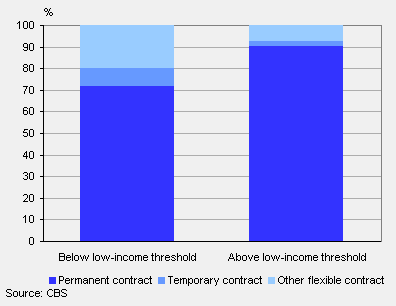370 thousand workers living on incomes below the poverty line

Despite having paid jobs, 370 thousand households in the Netherlands were living below the poverty line in 2009. The main reasons are that people earn low wages or have very low or negative incomes from operating their own business.
Half of persons below poverty line on the payroll
In 2009, nearly 700 thousand 18 to 65-year-olds living in households had incomes below the poverty line. More than half ((370 thousand) of them had paid jobs in 2009. After a decrease in 2006 and 2007, the number currently far exceeds the 2005 level. Three in every ten working people in this category with risk of poverty were self-employed.
Employed people (18-64 yrs) below the low-income threshold, 2005-2009*

High interest charges part of the problem
Often, low wages and very low or negative incomes from operating one’s own business are the direct causes for living below the poverty line. Other reasons are negative income from personal capital, e.g. paid mortgage interest and interest on consumer credit. On average, 9 percent of all households of employed living on low incomes dropped below the poverty line as a result of high interest charges.
Highest risk for self-employed in sectors trade and hotels and restaurants
In the sectors trade and hotels and restaurants ((25 percent) and the sector agriculture and fisheries ((22 percent) of self-employed were living below the poverty line; considerably more than among self-employed with higher incomes (15 and 9 percent respectively). In financial and business services, but also in the construction sector and the sector health care and welfare, self-employed with a risk of dropping below the poverty line were in fact underrepresented.
Self-employed (18-64 yrs) by household income and economic sector, 2009*

Higher risk of poverty for temps and flex workers
People on incomes below the low-income threshold are more often working on temporary or flexible employment contracts. For example, 28 percent of workers with a risk of poverty were temps or flex workers versus 9 percent of workers with higher incomes.
Employees (18-64 yrs) by household income and type of employment contract, 2009*

Boukje Janssen and Wim Bos